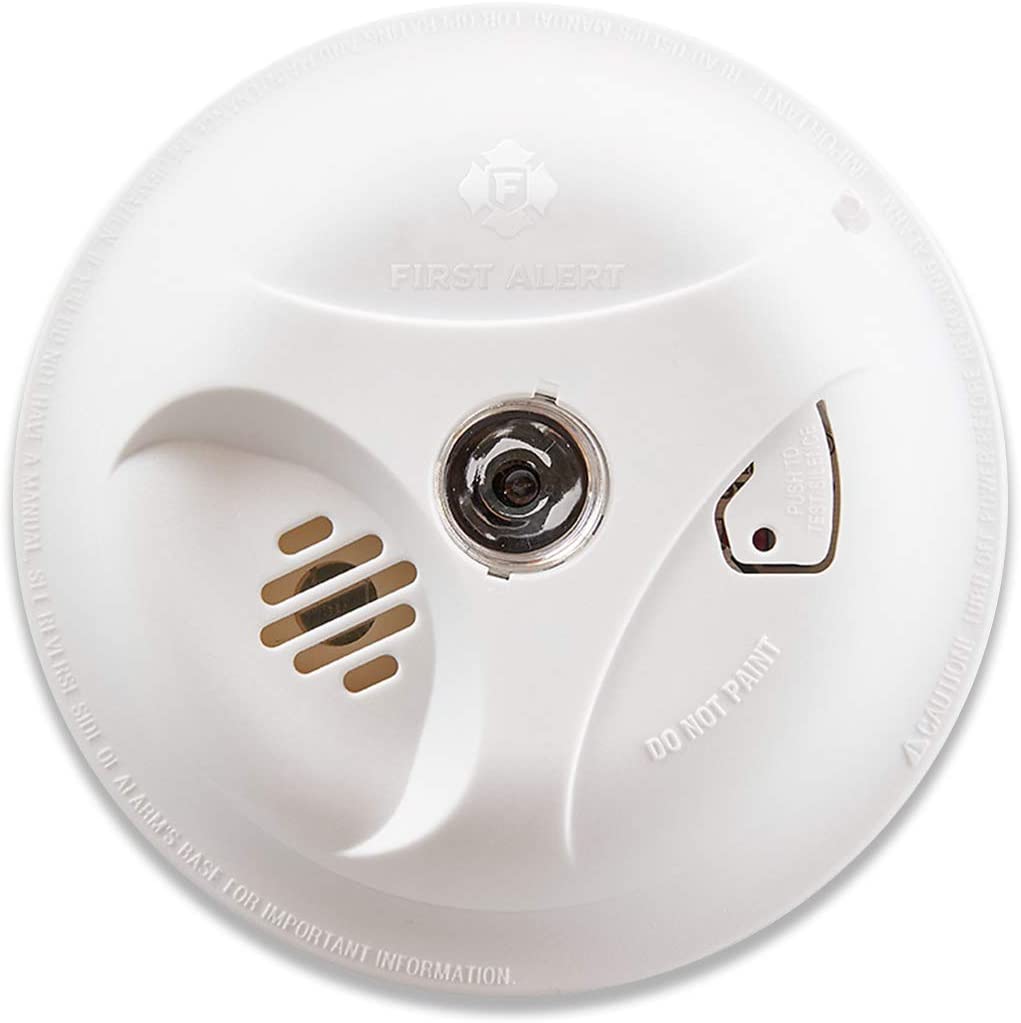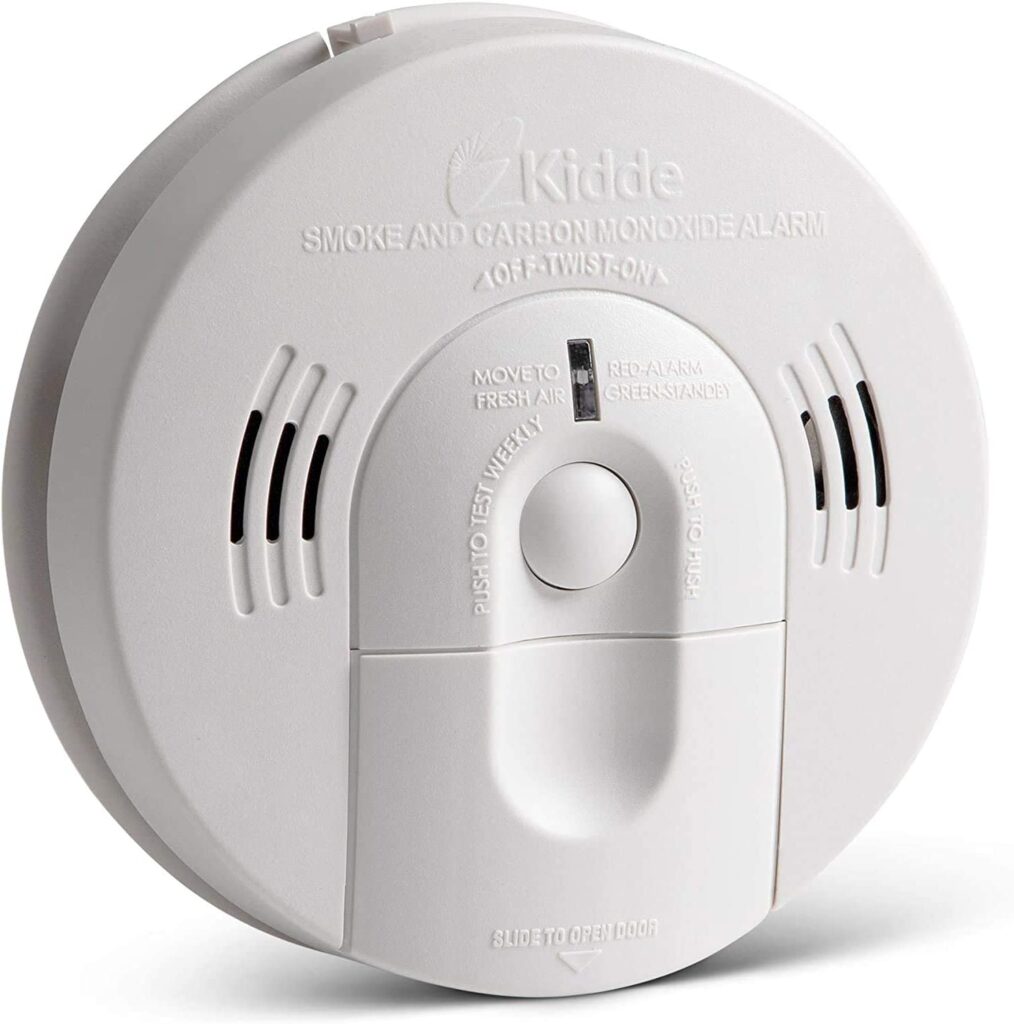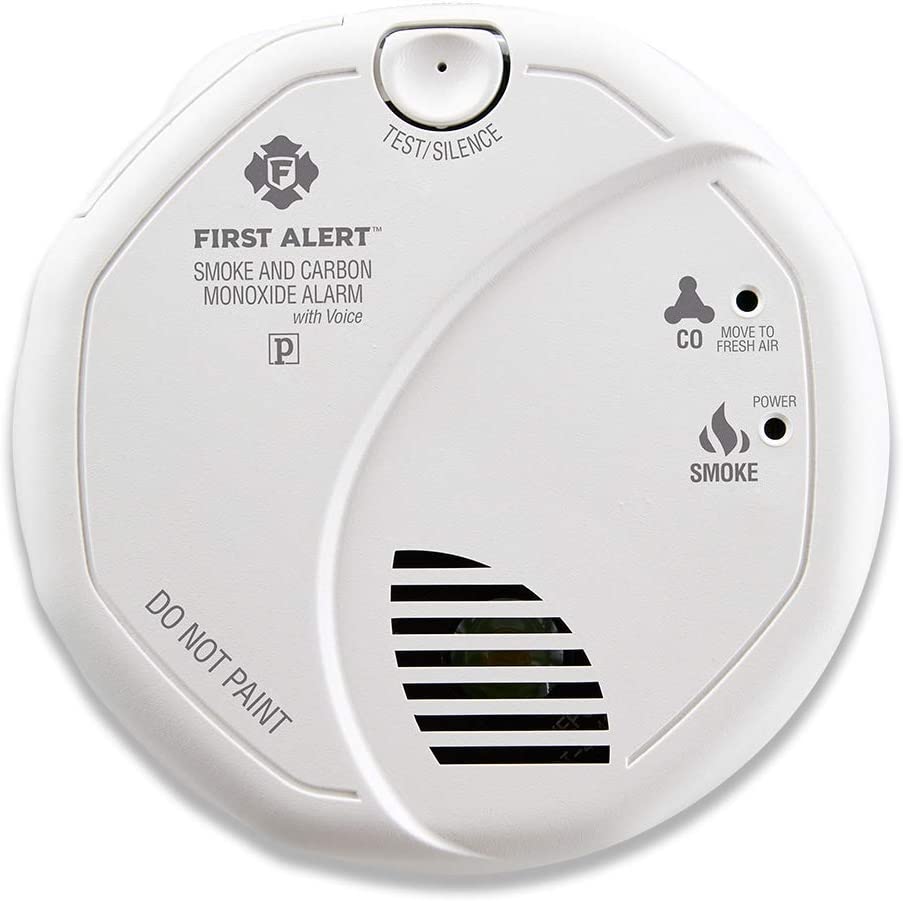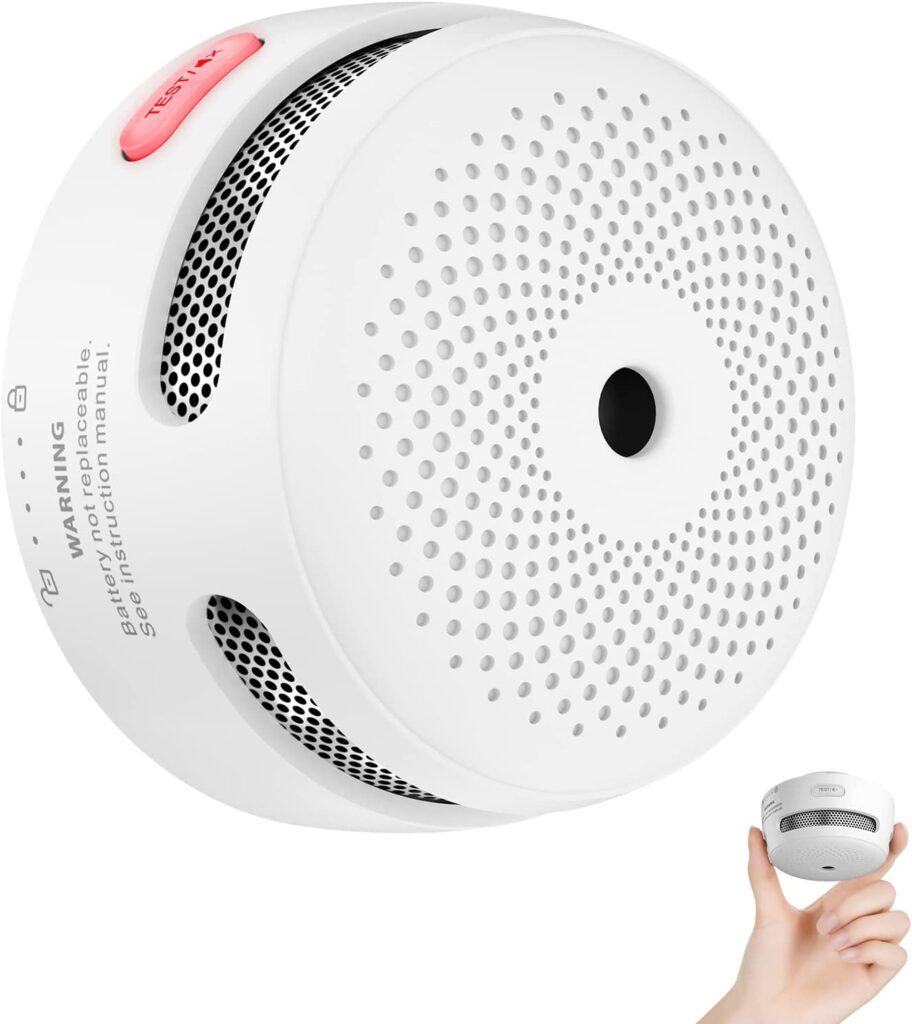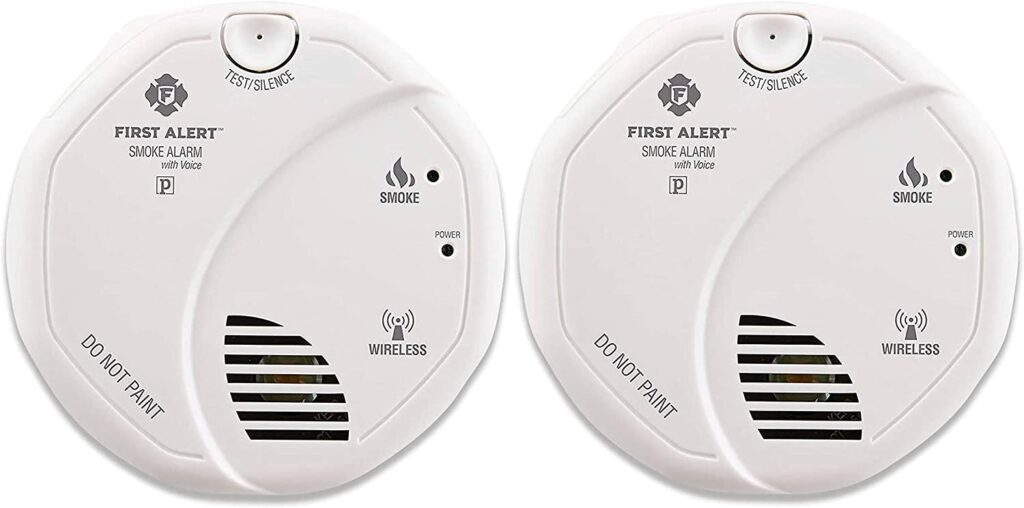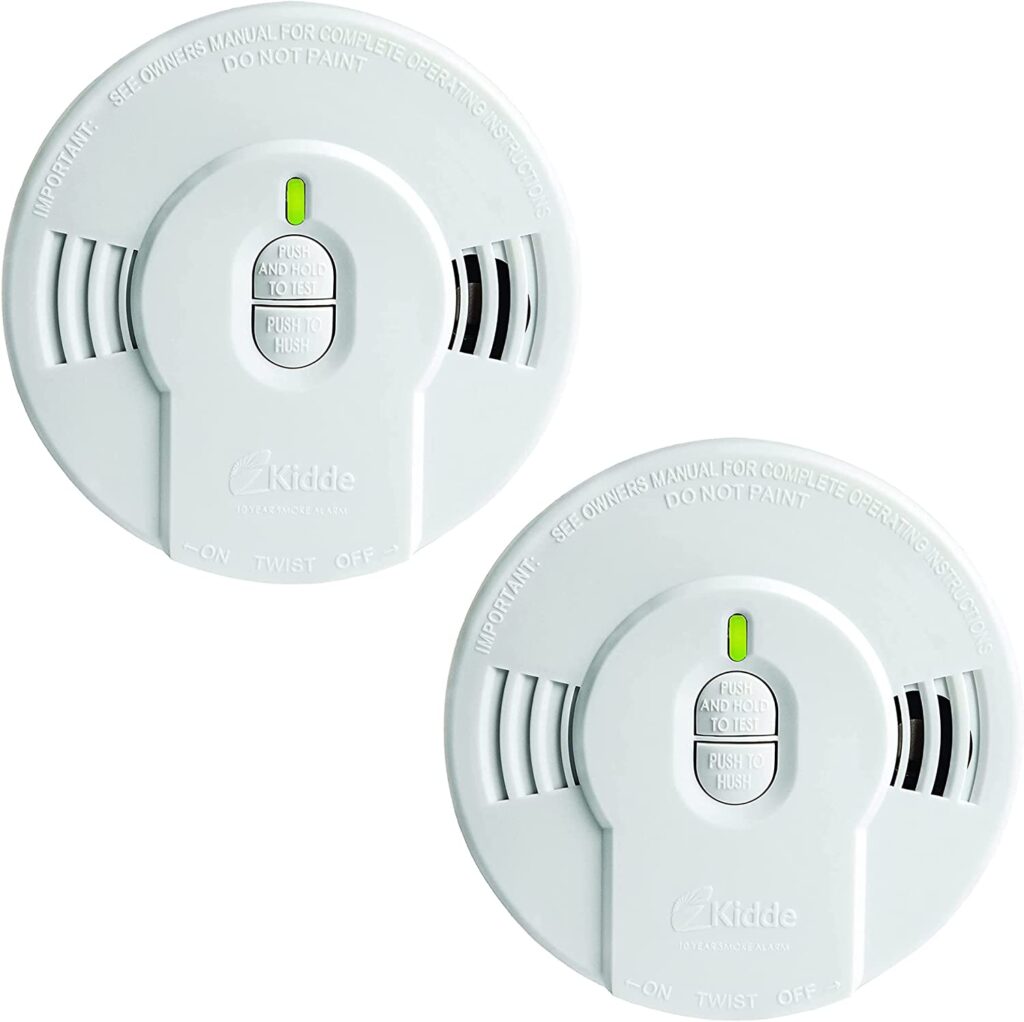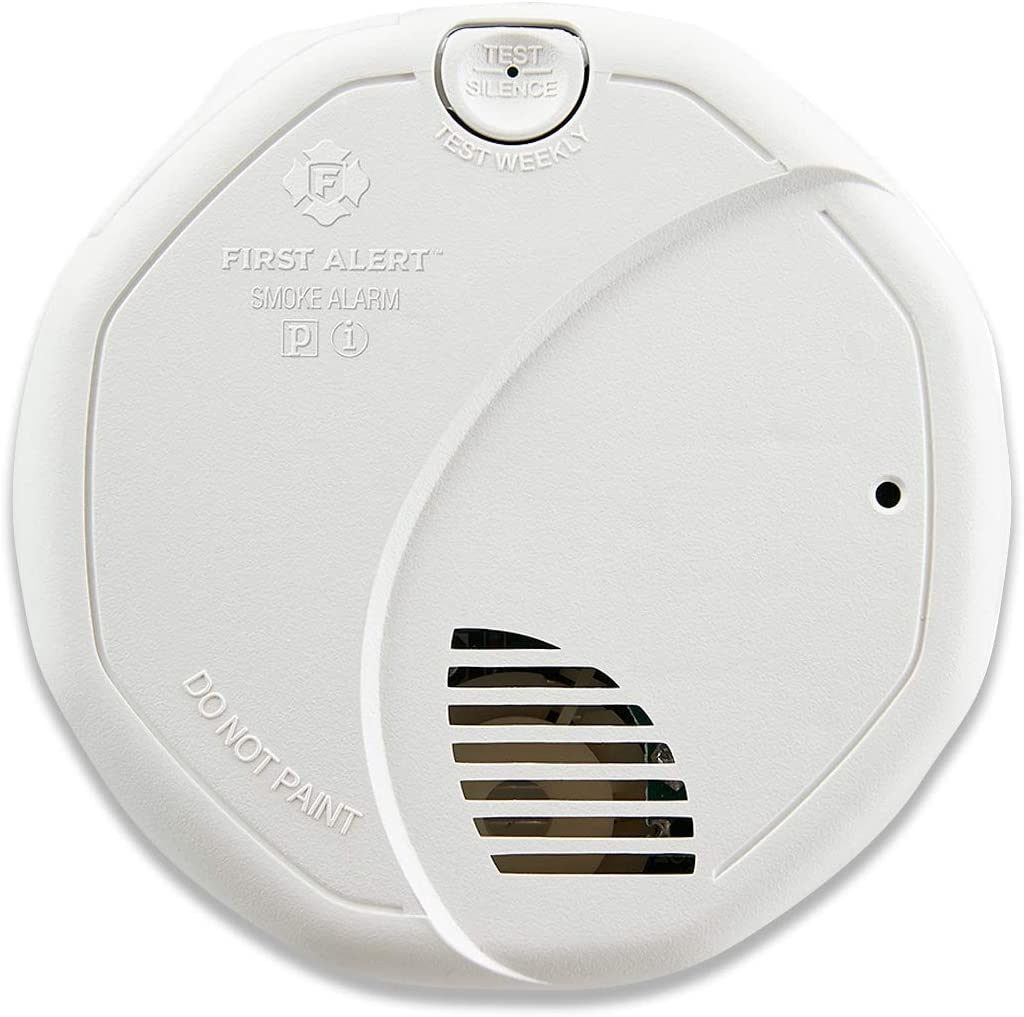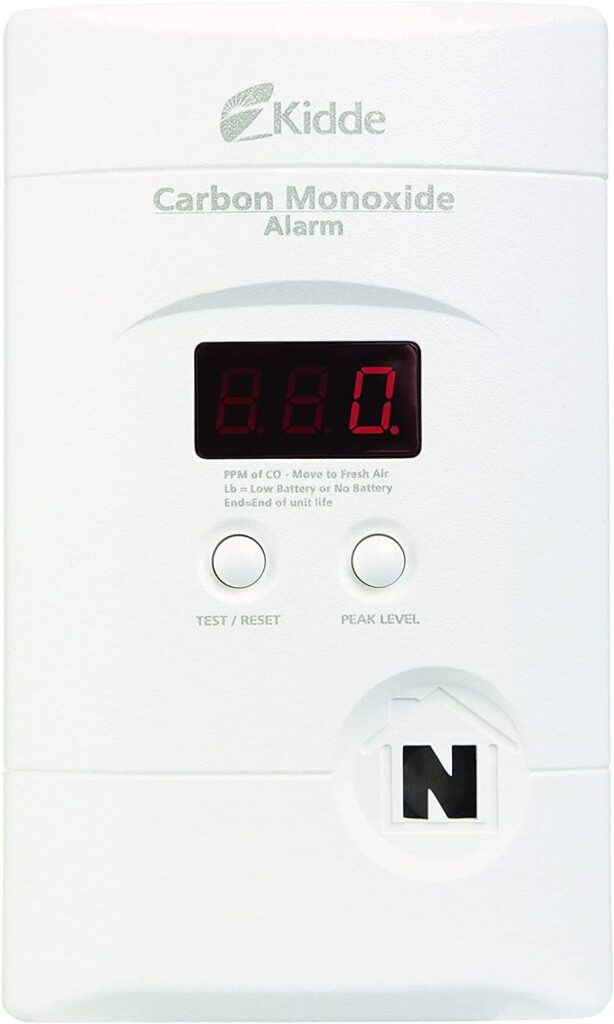Shopping for the best smoke detector and carbon monoxide detector can be overwhelming at first. Once you narrow them down it’s much easier to pick the right one for your situation. In this article I will talk to you about picking the best model to protect your loved ones. Let’s dive deeper into what’s important when finding the best smoke detector for your household.
A smoke detector is something we install in rooms of our house to warn us when there is a fire. It gives us plenty of time to escape or extinguish the flames. To learn more about what rooms should have smoke detectors, visit my article on proper Placement Of Smoke Detectors.
Beyond the most basic function of alerting us when there’s a fire, there are several other key features to consider. Let’s start by talking about the types of detectors, and what features may be offered.
I will start off by showing you four of my top pick smoke detectors. Hopefully one of these is what you are looking for. It’s okay if they are not what you need. This article will guide you through every consideration when looking for the best smoke detector for your situation.
Kidde Smoke & CO Detector

A smoke and carbon monoxide combination alarm just makes more sense. This battery powered model keeps you safe, even when the power is out.
Google Nest Protect

The best “smart” smoke detector available. The Google Nest Protect will protect your home, and then some!
Kidde Smoke & CO Detector
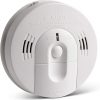
A smoke and carbon monoxide combination alarm just makes more sense. This battery powered model keeps you safe, even when the power is out.
First Alert Smoke Alarm
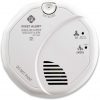
This option is the best for homes with a hard wired connectivity. Includes a voice alarm along with sound, alerting you to what room the danger is in
Table of contents
- Smoke Detector Function
- Smoke Detector Battery Life
- Safety
- Popular Brands
- Interconnectivity
- Hard Wired vs Battery Operated
- Smart Features
- Monitoring
- Carbon Monoxide
Best Smoke Detectors and Carbon Monoxide Detectors
- Best Smoke Detector For The Money
- Best Battery Powered Smoke And Carbon Monoxide Detector Combo
- Best Hard Wired Smoke And Carbon Monoxide Combo
- Best Smart Smoke And Carbon Monoxide Alarm
- Best Smoke Detector For Kitchen
- Best Smoke Detector For Mobile Homes
- Best Wireless Interconnected Smoke Detectors
- Best Ionization Smoke Detector
- Best Photoelectric Smoke Detector
- Best Dual Sensor Smoke Detector
- Best Smoke Alarm For Hearing Impaired
- Best Carbon Monoxide Detector
- Google Nest Smoke Detector
- X Sense Smoke Detector
Types of Smoke Detectors
Smoke detectors are available with two sensor types. These are each efficient at alerting you of a particular type of smoke more quickly. This does not mean that one sensor type will not work on the other type of smoke. There are different types of smoke that each sensor is quicker at finding.
Photoelectric Smoke Detectors
The photoelectric sensor is efficient at alerting you to smoke with larger particles. This is present in smoldering fires that do not have much of a visible flame. These fires are capable of burning for days before becoming a bigger issue. Think of a campfire at the end of the night when all that’s left are smoldering coals.
This sensor works by a led light that shoots across a chamber. There is a sensor that is perpendicular to the beam, and won’t trigger the alarm unless the light hits it. This happens when the light reflects off a smoke particle and bounces towards the sensor.
The sensor may be susceptible to dust accumulating on it over time. A monthly maintenance of blowing compressed air on the alarm will help make sure the alarm is in optimal working order. Another option is to go with a smoke alarm with an ionization sensor if your location allows them.
Ionization Smoke Detectors
The ionization sensor is good at detecting smoke with fine particles. This type of smoke is common in fires with fast burning flames.
The ionization sensor works by utilizing a chamber that houses ions being held in place with an electric charge. The sensor knows exactly how many ions there are, and therefore knows when they are disturbed. When smoke enters the chamber, the ions bond with the smoke, pulling them away and causing the alarm to trip.
Dual Sensor Smoke Detectors
The dual sensor smoke alarm has the best of both sensor worlds. You no longer need to buy two smoke detectors to have both sensor options in your home. You get all the benefits of each sensor type, and are covered for fire burning in more types of materials.
Smoke Detectors Buying Guide
Smoke Detector Function: What is The Function of a Smoke Detector?
The most basic function of a fire alarm is to warn you when a fire is in your home. There are some other features available to consider as well. The next most important feature is including a built in carbon monoxide alarm. This alerts you when there is a danger of carbon monoxide poisoning, without requiring a separate device.
The interconnected feature will alert you of a fire in a separate room of your home, even when you are not in that room. There are wireless models that will connect to each other, making it possible to have this feature without requiring a hardwired line in your home. This is especially nice for larger homes.
I like the options that have built in app control. This means your alarm can connect to an app on your smartphone, sending you an alert when it is triggered. It also allows you to turn off the alarm from your phone.
Smoke Detector Battery Life: How Long Should A Smoke Detector’s Battery Last?
A battery powered smoke detector may offer a time range for their battery life. Some of the options listed above have built-in lithium batteries that don’t get changed for the entirety of its use. Ones with 9 volt batteries should be changed every 6 months.
There are some models that make it easy to change the batteries. They have a built-in hatch in the front, allowing easy access to the battery without taking the entire unit down.
Safety: What is The Safest Smoke Detector?
When looking for the safest smoke detector, you want to find one that offers both a photoelectric, and ionization sensor. This will alert you for either fire type more quickly. Some smoke detectors offer a monitoring service which will alert the fire department when there is a fire. This drastically speeds up the response time, giving a better chance to save your home.
Popular Brands: Including Kiddie, First Alert, Google Nest Protect
There are several reliable brands of smoke detectors worth mentioning. The ones I am about to talk about have all been listed in this article already. Two that have been around for a very long time are Kidde and First Alert. Both of these have different options with numerous built-in features.
Other brands worth mentioning are Google Nest Protect, and X Sense. These have some really cool features that make them worth looking at if you want a more modern smoke detector.
Interconnectivity
Some smoke detectors are capable of being interconnected. This means they can be linked together, allowing them to communicate with one another. These smoke detectors can be programmed in different zones of the home. This makes it easy for you to find the fire if you are not in the same area as the smoke.
There are two main ways to use this feature. One option is to use an interconnected smoke detector. You can do this if you live in a home that is prewired for them. Depending on what state you live in any home built after around 1992 will have the wiring for this option built in.
This is the “hard wired” option when looking at purchasing smoke detectors. Not every home has this feature, but that’s okay because there is another option to get your smoke detectors to talk to one another.
The other way is for you to purchase several of the same smoke detectors with wireless interconnectivity built in. This means they will be talking to each other wirelessly, alerting you of a fire in one area of the home when you are in another, and not near the smoke.
I will be discussing the best options for smoke detectors with these features down below. Keep reading to learn more about the interconnectivity feature as well as other features for smoke detectors.
Hard Wired vs Battery Operated
Hard wired smoke detectors are physically connected with a wire. This is the interconnected feature discussed above. There are pros and cons to this feature. The most important pro is they will alert you when you are in a different room nowhere near the smoke. With some models you can set different zones, allowing the alarm to alert you to which zone the smoke is in. This is nice for larger homes.
These are also powered directly by an ac power source. This means you don’t need to change the batteries as frequently. The hard wired alarm models available today also include a battery backup, ensuring they will continue running even in the event of a power outage.
Battery operated smoke detectors run off a battery inside the unit. The main downside to a battery operated smoke detector may be changing the batteries. There are models that you won’t be able to change the batteries. These are lithium ion batteries that last 10 years which is the lifespan of the smoke alarm.
Smart Features
There is an array of smart features available in modern smoke detectors. This can range from shining a night light onto the floor when you are walking down the hall in the dark, to being able to point out what part of the room the smoke is coming from. Some smoke detectors will alert your phone that there is smoke at your home, even if you’re not there.
One of the most important smart features is Monitoring. This will notify the fire department if there is smoke at your house. I particularly like it when the alarm turns off the airflow in your home, reducing the amount of fresh oxygen feeding the fire.
Monitoring
The monitoring feature with some smoke detectors is potentially life saving. This is when a smoke detector is tripped, it sends a signal to an emergency response team like the fire department, speeding up the time for them to arrive on the scene. In a crisis like this every second is precious. This gives the ability to potentially save more lives and have less destruction of property. Additional fees may apply for this feature.
Carbon Monoxide
Carbon monoxide is extremely dangerous when allowed to build up in an enclosed space. This is why there are many smoke detectors on the market that also include a sensor for carbon monoxide. This is not always necessary, but it is nice to have something that houses both sensors in one place.
There can be a host of reasons CO can build up in a home. A couple options would be poorly ventilated gas appliances, or wood burning devices like fireplaces.
Thankfully there are several types of carbon monoxide alarms on the market, making it easy and affordable for you to protect your family in an event like this.
For a more in-depth discussion on where to put these devices in your home, visit my article on Smoke And Carbon Monoxide Placement.
Best Smoke Detectors and Carbon Monoxide Detectors
There are a lot of different options to choose from these days. That’s why I put together this list of the best smoke detectors for you to look through. Hopefully you will find the right ones to suit your needs.
There are some basic criteria for me to consider adding a model to the list. For instance, I am looking at the lifespan of the unit, what fire detection niche it might fit, and what other features it might have. Below is a list of categories when looking for a new smoke detector.
Pros
- Ionization sensor
- Built in escape light
- 85 decibel alarm
- Battery Powered
Cons
- Difficult to remove from bracket once installed
For those of us on a fixed budget, we don’t need to sacrifice our family’s safety. That’s why I want to tell you about the First Alert Smoke Alarm With Escape Light. This company has been a major player in the fire safety niche for many years, so you know they won’t be cutting corners with any of their products.
It runs on a 9 volt battery (included), which keeps on working even in the event of a power outage. The alarm uses an ionization sensor which works great for fine particle invisible smoke. It will alert you with an 85 decibel alarm, which is loud enough for almost anybody. At such an affordable price there’s no reason not to choose this option, even on the tightest budget.
Pros
- Ionization sensor
- Fire and CO detector
- 85 decibel alarm
- Test/hus button easily accessed
- UL certified
Cons
- Battery operated
- Not 10 year battery life
Kidde Smoke and Carbon Monoxide Combo is the overall best choice. This model has a 10 year warranty (excluding batteries). It includes a Hush/Test Button that will quickly silence the alarm, as well as allow you to quickly test if the alarm’s batteries are charged. The voice alarm feature will warn of smoke, carbon monoxide danger, or if the unit has a low battery. There is a front battery door that makes changing the batteries quick and easy.
Pros
- Photoelectric sensor
- Talking feature included
- Interconnected alarms
- BRK compatable
Cons
- Requires monthly maintanence
- Not 10 year battery
First Alert makes a hardwired smoke and carbon monoxide alarm that’s the perfect choice, especially for newer homes. With all the alarms hardwired together, they will tell you what room the issue is in, even if you are not in the same room as it. You can program up to 11 locations in your home, and all the units will alert you simultaneously. Comes with a 10 year limited warranty.
Pros
- Photoelectric and electrochemical sensor
- Both wired and battery available
- Sends messages to smartphone
- Built in path light
Cons
- Expensive
- Path light can not be deactivated
Google Nest Protect is the best “smart” option for a smoke and carbon monoxide combination alarm. It includes a built-in sensor that will be looking for both fast burning and smoldering fires, telling you what direction they are in. The built-in ring light will give you a “nightly promise” of the battery each night when you turn off the room lights. If you have a Google smart home, then this Nest Protect smoke detector is the perfect option for you.
Pros
- Photoelectric sensor
- Low profile means discrete in room
- 85 decibel alarm
- Well known brand
Cons
- No additional features
- May get false alarms from cooking
- Sealed battery can not be changed
When looking for a smoke detector to put in your kitchen, you want one that won’t trip as frequently from a false alarm while cooking. The photoelectric sensor option is a good choice because it is designed to alert you to larger smoke particles caused by a smoldering fire. Burnt food tends to have finer particles, which is less likely to trigger this type of alarm as quickly.
The photoelectric option gives you extra time to clear the smoke out of the kitchen before the alarm goes off. That’s why I like this First Alert low profile alarm. Its slim design keeps it discrete in one of the most trafficked rooms of your house.
Pros
- Photoelectric sensor
- 10 year built in battery
- Compact size
- Warranty
Cons
- Not ideal for small particle smoke
- Not UL certified
Mobile homes can be a tight space to design in, making it ideal to have smaller items that will maximize your space. Thankfully the X-Sense Mini Smoke Detector allows just that. It has all the needed features for a smoke detector, all wrapped up in a small package. Good things come in small packages!
This photoelectric smoke alarm includes a test button and a silence button. It boasts an 85 decibel alarm which is more than enough to alert even the hardest sleepers.
Pros
- Photoelectric sensor
- Wireless connectivity up to 18 units
- 11 programmable locations
- 85 decibel alarm
Cons
- Does not announce problem room
The First Alert Wireless smoke alarm is an awesome option if you want an interconnected alarm system, but don’t have the wiring built into your house for it. These alarms will “talk” to one another, giving your family optimal safety in the event of a fire.
You are capable of connecting up to 18 alarms together as long as they are all compatible. They offer either a photoelectric or ionization alarm sensor option. You will hear an 85 decibel alarm that is powered by two AA batteries. There is a test/silence button, low battery warning, and an end of life timer.
Pros
- Ionization sensor
- Advertised 10 year battery life
- 85 decibel alarm
- Easy installation
Cons
- Battery may not last 10 years
When deciding on what type of sensor to use, ionization smoke detectors are an excellent choice. That’s why I’m recommending this model made by Kidde. You don’t need to change the battery for the entire lifespan of the alarm. It lasts for 10 years which is when you want to swap out for a new alarm anyways. And don’t worry because it will let you know when this time has come.
Pros
- Photoelectric sensor
- 10 year built in battery
- Compact size
- Warranty
Cons
- Not ideal for small particle smoke
- Not UL certified
If you’re looking for a photoelectric smoke detector, it’s time for you to look at the X-Sense Mini Smoke Detector. Not only does it boast a higher than 85 decibel alarm, but also has a flashing LED light for a visual alarm as well. Its small design makes it discrete even in the highest trafficked rooms in your house. 10 year battery life.
Pros
- Photoelectric sensor
- Ionization sensor
- 85 decibel alarm
- Uses AA batteries
Cons
- Batteries require changing
A dual sensor smoke alarm will give you quick alert time for fast burning or smoldering fires. That’s why you want to get yourself the First Alert Dual Sensor fire alarm. It’s a battery operated smoke alarm, making it so you don’t need to rewire your house for an interconnected model.
There is a test/silence button making it quick for you to either perform regular maintenance, or turn off the unit when needed.
Pros
- Ionization sensor
- Built in escape light
- 85 decibel alarm
- Battery powered
Cons
- Difficult to remove from bracket once installed
When looking for a smoke alarm for the hearing impaired there needs to be some added features involved. The first option I want you to see is made by First Alert. This one includes a built-in escape light, giving you a visible alarm as well as audible one. If you want a hardwired version, take a look here.
The above options are more affordable, but may not be exactly what you need. These fire alarm notification systems include several options for you to choose from. They use a combination of sensory alert mechanisms including audible alarms, strobing or flashing lights, and vibrations designed to alert you when you are sleeping.
Pros
- Electrochemical alarm
- Plug into wall outlet
- 9V battery backup
- UL certified
Cons
- Battery needs to be changed
Carbon monoxide can be just as dangerous as fires. That’s why sometimes you want to get a dedicated carbon monoxide detector. The Kidde Nighthawk is an option that plugs into any power outlet, keeping you safe from the dangers of carbon monoxide poisoning 24/7.
Even though it plugs into the wall, it also has a battery which keeps the unit running even in the event of a power outage. It has an 85 decibel audible alarm.
Pros
- App enabled
- Carbon Monoxide Alarm
- List Item #2
- List Item #3
Cons
- Expensive
- List Item #2
- List Item #3
- List Item
The Google Nest Protect is more than a smoke detector. That’s why I want to put it in a category all on its own. On top of being a photoelectric smoke detector, there are a lot of other cool features it offers.
It includes a “split-spectrum sensor” that is able to sense both a smoldering fire and an active flame. Once there is a fire in the area it will tell you the direction it is in.
It has a built-in carbon monoxide sensor as well. My favorite feature is when you walk under it in the dark it shines a white glow on the ground, helping you see your path. This light will change to different colors based on different warnings it is displaying.
When it’s triggered it will send you a notification to your smartphone, even if you are not at home. It will also give you a calm notification before sounding the alarm in case it’s a false alarm like burnt toast. You can also turn the alarm off from the app on your phone.
X Sense Smoke Detector
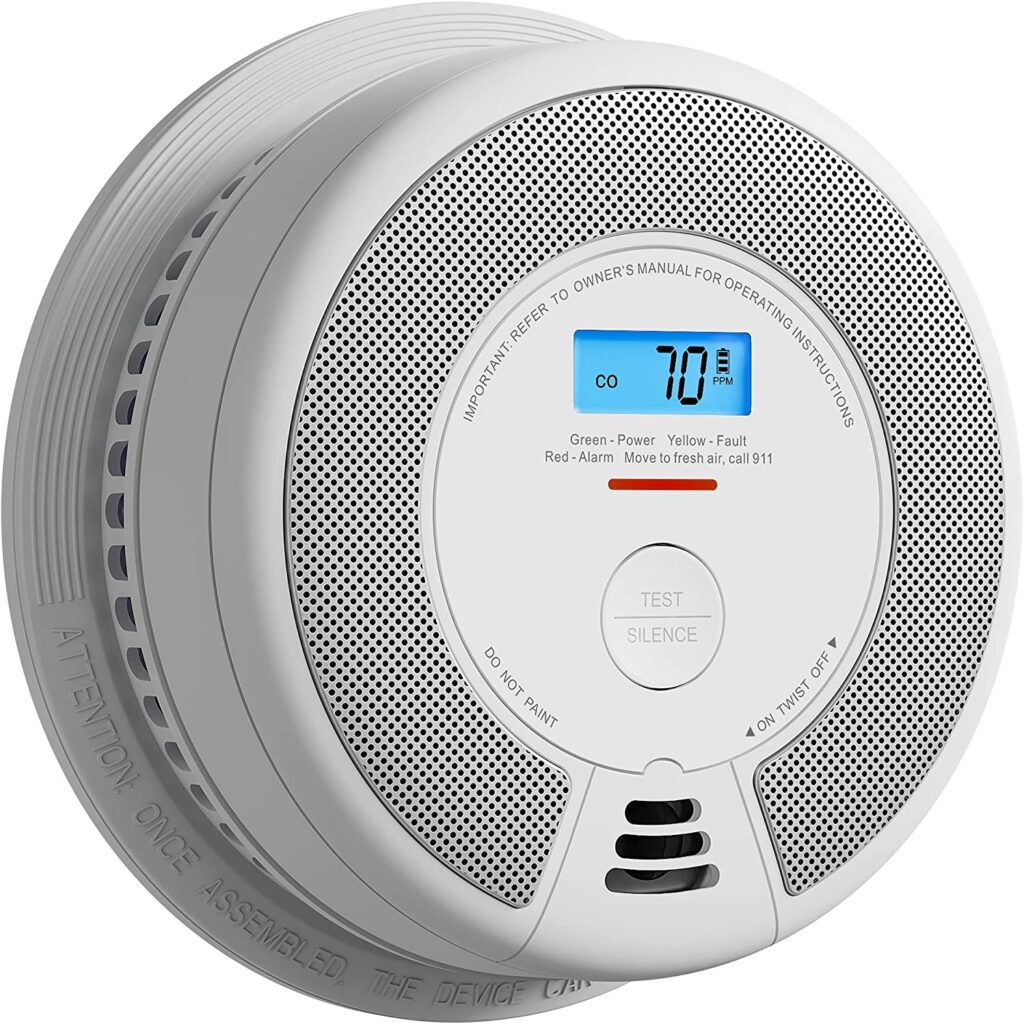
x-sense wireless interconnected
Pros
- Photoelectric Alarm
- Electrochemical Alarm
- RF Interconnected
- Battery powered
Cons
- Needs to be paired
X Sense is a brand that makes several very nice smoke detectors. They have more modern features that are worth a mention. They offer models with built in LCD screens to show you the carbon monoxide particulate levels in the air in real time. You can also see the battery level on the screen. There is a wirelessly connected version that will link to other units up to 850 feet away.
The company makes a series of different types of alarms that can all interconnect to one another. They will alert you when one alarm is triggered. You can press the silence/test button on one of the units to silence all the alarms except for the triggered one, or use the remote control to turn them off. The second time you push the button will turn all the alarms off.
Frequently Asked Questions
Why is my smoke detector going off when there is no smoke?
One possible reason why your smoke detector is going off when there is no smoke in the air is because its batteries are low. The sensitivity of the sensor increases when the battery power gets low. This will likely cause false alarms.
Another reason that causes false alarms is too much pollution in the air. Unfortunately air quality can be pretty bad in some areas. The best solution for this is to close the windows and turn on your air purifier.
Are there different types of smoke detectors?
There are two different types of sensors used in a smoke detector. The first one is called ionization which is better at noticing fine particle smoke from active flames. The second is a photoelectric sensor which will alert you to larger particle smoke produced from a smoldering flame more quickly. There are also dual sensor units that have both types of sensors built in.
How many smoke detectors should I have in my house?
The number of smoke detectors in your house is determined by the size of the house. A good guideline is there should be one in each sleeping room, one in the main living area, and one on each level of the house including the basement. Some states also require additional carbon monoxide detectors. To learn more about this question check out my article on Placement Of Smoke Detectors.
What smoke detector do firemen recommend?
Each of the two sensor types have different strengths. That’s why the USFA recommends using a fire alarm with both ionization and photoelectric sensors. This will ensure you have both sensor options working for you to help warn of fire dangers.
What is the most reliable type of smoke detector?
The dual sensor alarm is the most reliable type of smoke detector. Both sensor types are quicker than the other at alerting specific types of smoke. You will have an ionization alarm that picks up fast burning flame fires, as well as a photoelectric sensor for any slow burning smoldering fires.
What is better, Kidde or First Alert?
First Alert is oftentimes considered a better option because it offers both an audio alarm as well as a talking voice. It’s nice having a verbal warning of smoke in a smoke alarm. The model listed here allows you to connect to a ring alarm base station, as well as other smart home systems.
What is the best 10 year smoke detector?
First Alert makes an excellent 10 year smoke detector. What a 10 year smoke detector is, is one with a lithium ion battery sealed in it. The battery does not need to be changed until the lifespan of the smoke detector has been met, which is 10 years.
Conclusion
With all the smoke detector options on the market today, it’s easy to feel overwhelmed with the task of picking one. This article was designed to walk you through some of the most important features, and reasons for owning a smoke and carbon monoxide alarm.
Make sure you check your regulations because each state, and possibly county can have separate laws regarding what type of smoke detector you should use. I go more in depth on this in my article on smoke detector placement.
I hope this article helped you find the perfect smoke detector for your situation. If you have any questions about this topic, or others like it, please leave a comment down below. And thank you for checking out the Castle Remodel blog.
Happy Home Owning,
Kevin

